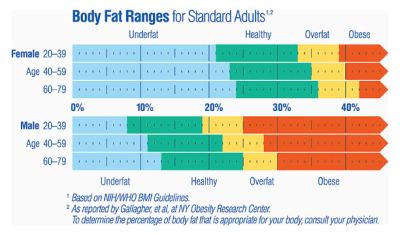You go to the gym or you run or you go for long walks and you are addressing the balance of carbs and protein in your diet. Yet one week you get on your bathroom scales your weight remains unchanged. How to best measure your progress? Scales are not the only answer because they dont not take into account your body's composition. This is what your body is made up of, how much fat you have relative to lean tissue. By figuring out your body fat percentage you can get a better look at how your body is composed and how "healthy" you are.
Depending on your age, sex and how active you are the level of your body fat percentage will vary. Your body fat percentage is a measurement of the amount of your total body mass that fat, as opposed to lean body mass (muscle, bones, organs, tissues, blood, and anything else). So, for example, if you weigh 200 pounds and you have 30% body fat, this means that your body contains 60 pounds of fat and 140 pounds of lean body mass.
Measuring changes in body fat percentage, rather than just measuring changes in weight, can be very motivational when you're dieting. A measurement of ones body fat percentage is a more accurate measure of your excess body weight than your BMI, or body mass index, measurement would be because this does not take into account ones body frame size, nor does it account for the amount of muscle mass a person has. However, body fat percentage is not as popular as BMI's because the skills and technology needed to measure body fat percentage are not readily available. Until now..
At your local wellness club wellness club you can get these body fat % measurements taken weekly, as well as visceral fat, metabolic age, muscle mass, % body water, physique rating, BMR and bone mass. All the information you need to monitor your progress.
Visceral fat surrounds the internal organs in the stomach/trunk area of your body. High levels of visceral fat increase the risk of high blood pressure, heart disease and type 2 diabetes. Monitoring your results can help you to stay in the low risk range.
Acceptable levels of body fat vary depending on age and sex. Healthy body fat percentages for men and women aged 20-39 are levels between 21-32% for women and 8-19% for men; while those who are aged 40-59 will remain healthy by maintaining levels 23-33% for women and 11-21% for men; finally 60 + will be fine with levels of 24-35% for women and 13-24% for men. While athlete's body fat percentages usually range between 14-20% for women and 6-13% for men. See the chart below for more details.
Women require a higher body fat percentage than men do and this extra amount of fat is natural for them as well. Also you probably noticed that with how active a person you are usually your fat percentage is lower and also that as you age increases your fat % will increase naturally along with you.



Comments